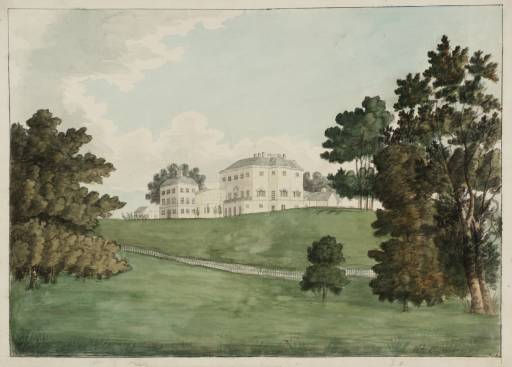Joseph Mallord William Turner View of Nuneham Courtenay from the Thames 1787
Joseph Mallord William Turner,
View of Nuneham Courtenay from the Thames
1787
Joseph Mallord William Turner 1775–1851
View of Nuneham Courtenay from the Thames 1787
D00002
Turner Bequest I B
Turner Bequest I B
Watercolour and pencil, 302 x 422 mm on laid paper, 318 x 447 mm
Watermark ‘I Taylor’
Inscribed by Turner in ink ‘Wm Turner | 1787’ lower right
Blind-stamped with Turner Bequest monogram
Stamped in black ‘I – B’ bottom right
Watermark ‘I Taylor’
Inscribed by Turner in ink ‘Wm Turner | 1787’ lower right
Blind-stamped with Turner Bequest monogram
Stamped in black ‘I – B’ bottom right
Accepted by the nation as part of the Turner Bequest 1856
Exhibition history
1904
National Gallery, London, various dates to at least 1904 (852, as ‘Nuneham Court, near Oxford’).
1988
Young Turner: Early Work to 1800: Watercolours and Drawings from the Turner Bequest 1787–1800, Tate Gallery, London, January–March 1988 (1, reproduced).
References
1904
E.T. Cook and Alexander Wedderburn eds., Library Edition: The Works of John Ruskin: Volume XIII: Turner: The Harbours of England; Catalogues and Notes, London 1904, p.643 no.852, as ‘Nuneham Court, near Oxford (early)’.
1909
A.J. Finberg, A Complete Inventory of the Drawings of the Turner Bequest, London 1909, vol.I, p.1, I B, as ‘Clifton, Nuneham Harcourt, nr. Abingdon’.
1920
D[ugald] S[utherland] MacColl, National Gallery, Millbank: Catalogue: Turner Collection, London 1920, p.45.
1961
Alexander J. Finberg, The Life of J.M.W. Turner, R.A. Second Edition, Revised, with a Supplement, by Hilda F. Finberg, revised ed., Oxford 1961, p.15.
1979
Andrew Wilton, J.M.W. Turner: His Life and Work, Fribourg 1979, p.300 no.6, reproduced, as ‘Clifton, Nuneham Harcourt, near Abingdon’.
1987
Andrew Wilton, Turner in his Time, London 1987, p.20.
1990
Joyce H. Townsend, ‘Turner’s Painting Materials: A Preliminary Discussion’, Turner Studies, vol.10 no.1, Summer 1990, p.23, fig.1.
1997
Anthony Bailey, Standing in the Sun: A Life of J.M.W. Turner, London 1997, p.17.
Technique and condition
The paper used for this composition is an off-white, laid writing paper made with a single-faced mould. Its watermark reads ‘I Taylor’ and it was made by James Taylor at Poll Mill in Maidstone, Kent. The image has been painted on the wire side of the sheet using ink and watercolour with a pencil under-drawing.1
‘Although from the same maker as [Tate D00001; Turner Bequest I A], this is a half sheet from a different batch of paper, made on a larger mould, probably Demy Writing (approximately 22½ x 17 inches [572 x 432 mm]) or Medium Writing (23 x 18 inches [585 x 458 mm)’. Bower goes on to note that interestingly at this early date Turner is already experimenting with different papers even from the same maker. As merchants and stationers stocked papers from specific mills it is possible this sheet, and the other Taylor papers form the period, were purchased together from the same supplier.2
The windows have been painted freehand and there is no pencil under-drawing. The grey-black border around this picture was painted last. The green in the foreground has been created with a single mixed wash made from a mixture of fine-grained yellow and blue pigments, whereas the green of the trees has been created by mixing a coarse yellow lake with (probably) brown ochre and black; in the distance another yellow and blue mixture was used to create another shade of green. Turner used his fingers to manipulate the paint, and left discernable fingerprints. Other pigments used include Indian yellow and another red lake. These last fade readily when exposed to light, and the rather blue tonality of the green foreground and the trees nearest to the house is likely to be due to fading of yellow from the mixed greens.
Helen Evans
July 2008
Revised by Joyce Townsend
January 2011
How to cite
Helen Evans, 'Technique and Condition', July 2008, revised by Joyce Townsend, January 2011, in Andrew Wilton, ‘View of Nuneham Courtenay from the Thames 1787 by Joseph Mallord William Turner’, catalogue entry, April 2012, in David Blayney Brown (ed.), J.M.W. Turner: Sketchbooks, Drawings and Watercolours, Tate Research Publication, December 2012, https://wwwFinberg knew this subject as ‘Clifton, Nuneham Harcourt, near Abingdon’. It is probably copied from a print. Paul Sandby had made a large oil painting of a very similar composition, showing Nuneham Harcourt seen from the Lock Cottages, one of a pair he sent to the inaugural exhibition of at the Society of Artists of Great Britain in 1760 (private collection);1 however, this was not apparently engraved. The care with which the details of the architecture are transcribed betrays Turner’s early concern for this aspect of topographical work. Compare the sketch of this view made on the spot in 1789 in the Oxford sketchbook (Tate D00022; Turner Bequest II 10), which is taken from a similar viewpoint but has the river and a sailing boat in the foreground. Townsend lists the pigments used in this view: see the introduction to the present section.
Verso:
Blank; inscribed (in another hand?) ‘Do House from [?Grounds]’; in a later hand ‘Turner Unmounted, Vol. 92’; in another hand ‘127’.
Andrew Wilton
April 2012
How to cite
Andrew Wilton, ‘View of Nuneham Courtenay from the Thames 1787 by Joseph Mallord William Turner’, catalogue entry, April 2012, in David Blayney Brown (ed.), J.M.W. Turner: Sketchbooks, Drawings and Watercolours, Tate Research Publication, December 2012, https://www

